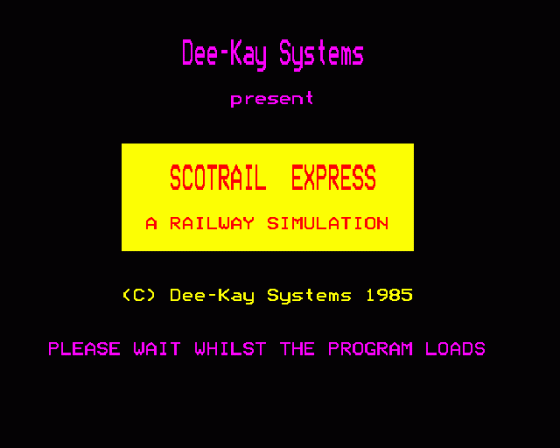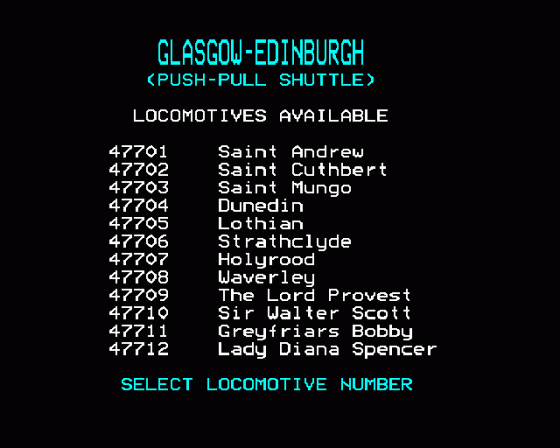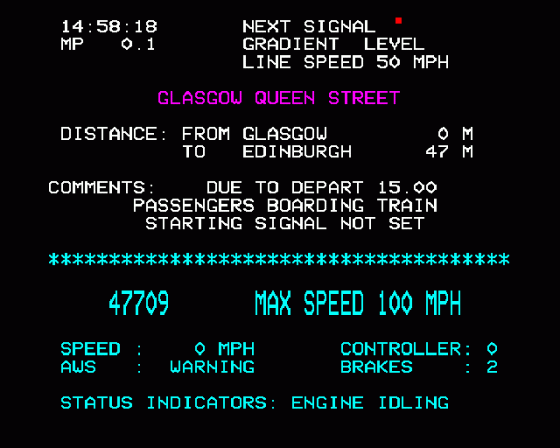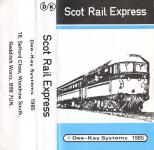



| Genre: | Game: Simulation |
| Publisher: | Deekay |
| Cover Art Language: | English |
| Machine Compatibility: | BBC Model B |
| Release: | Professionally released on Cassette |
| Available For: | BBC Model B & Spectrum 48K |
| Compatible Emulators: | BeebEm (PC (Windows)) PcBBC (PC (MS-DOS)) Model B Emulator (PC (Windows)) |
| Original Release Date: | 1st January 1985 |
| Original Release Price: | £9.99 |
| Market Valuation: | £2.69 (How Is This Calculated?) |
| Item Weight: | 64g |
| Box Type: | Cassette Single Plastic Clear |
| Author(s): | - |
Variant Items
There are 0 other items featuring this same game (that we know about!). Click any of them for their details.
Active Auctions
Closed Auctions
Buy It
Unfortunately no-one is currently selling this item.
Auction Price Watch
Worried you're being ripped off? Closing prices on eBay can help you decide what a reasonable price is for a particular item.
Full Instructions
Introduction
In this simulation, set in the early 1980s, you are the driver of a Class 47/7 locomotive on one of Scotrail's crack 100mph push-pull trains from Glasgow Queen Street to Edinburgh Waverley and back. Although only a relatively short journey of just over 47 miles each way, it is one which is demanding of both driver concentration and locomotive performance if the tight schedule of this intense Inter-City shuttle service is to be maintained.
Display Format
The simulation is presented as a two-part display on the television screen; the upper section giving information a driver would have from visual observations and his background knowledge of the route, and the lower section being a monitor of the locomotive controls and performance. For consistency milepost distances (MP) in both the up (to Edinburgh) and down (to Glasgow) directions are expressed in integer tenths of a mile from the milepost origin at Queen Street buffers.
The Route, Speed Restrictions And Signalling
The direct route between Scotland's principal cities runs via Falkirk, and apart from the steep incline out of Queen Street to Cowlairs the line is remarkably finely engineered, with no gradient steeper than 1 in 880.
The line speed is nominally 100mph, but there are numerous sections with lower limits and you may also encounter restrictions due to engineering work on the track. Notification of any such 'permanent way slacks' will be given in the roster notices at the start of the simulation, and during your run you will be given a reminder as you approach all reductions in the permitted line speed (this advance warning commencing 1.5miles befoore any pws slacks and 1.0 mile before other restrictions, unless these form part oof a stepped series of reductions in which case the warning distance may be less).
The line is signalled with multiple aspect colour lights throughout, which means that there will be a sequence of at least a signal at double-yellow and a signal at yellow preceeding a signal at red. The distances between signals are typically only 0.7 mile, and as such if you are travelling near the line speed you will have to breake hard for much of the time under adverse signals to keep your speed under control. All signals at caution or danger trigger a cab warning alarm (AWS), which if not cancelled within six seconds will bring an automatic application of the train emergency brake.
Motive Power And Train Schedule
Push-pull operation between Glasgow and Edinburgh began in 1971 when ageing Inter-City DMUs were replaed by coaching stock sandwiched between pairs of specially adapted Class 27 locomotives. The liitations of this set-up were however soon apparent, and in 1976 plans were laid for the present style of push-pull service with a single Class 47 locomotive at one end of the train, and a driving trailer converted from a MkII brake at the other. A simple but effective control system was developed using signals transmitted through the coash lighting circuits, and operation began in late 1979 with twelve modified Class 47/4 locomotives (re-designated as the Class 47/7 sub-class) and specially adapted sets of MkIII coaching stock. The locomotive is normally on the Edinburgh end of the formation, and consequently is driven from the cab as usual on the journey to Edinburgh but from a MkIIf DBSO (Driving Brake Second Open) at the other end of the train on the return to Glasgow. The improved service sooon settled down, and a popular move was the adoption of appropriate local names for the first 11 of the converted locomotives (47712 being timely named after Lady Diana Spencer to commemorate the royal engagement in 1981). Stock utilisation is high, and space shuttle sets are now used for push-pull services from Queen Street to Aberdeen and Perth.
The schedule of your trains, the 15.00 from Glasgow and the 16.00 return, is given in the Appendix. The journey from Glasgow has just a single intermediate stop in the Edinburgh suburbs at Haymarket, but after changing ends in one of the terminus platforms at the western end of Waverley you have calls at both Haymarket and Falkirk on your return. It is normal practice for drivers to 'miss a turn' between workings, but in the simulation you are rostered to stay with the stock and return to Glasgow on the next scheduled service.
Locomotive Controls And Driving Technique
The tractive characteristics of a Class 47/7 locomotive and your relatively lightweight train of 210 tons are realistically reproduced in the simulation, allthough the controls have been somewhat simplified to the now standard DKS system.
Engine power is varied by adjustment of a master controller which is calibrated between 0 (engine idling with drive disconnected) and 5 (full throttle). Current is supplied to the traction motors by a generator, and care must be taken not to cause an overload by applying too much power at low speed (warning not to continue with notching up being given by the 'high generator current' message on the status indicator). At speed there are several stages of generator field diversion to maintain efficiency, but these occur automatically and require no action by the driver.
The brake handle is similarly calibrated between 0 (off) and 5 (full on) although position 5 should be used in emergencies only, the maximum appliation in normal service being setting 4. You should brake with caution as you approach adverse signals, and if a signal remains at red you should bring your train to a halt within 35 yards of it in order to obtain telephone instructions from control about the situation. There are controlled signal approach sequences to all station stops, and once in the platforms you should again draw up within 35 yards of either the starting signal or the buffers to be correctly positioned for passenger boarding and/or alighting.
The computer keys used for locomotive control are:
| Controller: | Increase | > (BBC) or P (Spectrum and Commodore) |
| Decrease | < (BBC) or O (Spectrum and Commodore) | |
| Brakes: | Increase | X |
| Decrease | Z | |
| AWS Cancel: | Space Bar | |
| Horn: | Available on BBC only by pressing Shift (a short press giving a starting acknowledgement and a longer press a twin tone warning) | |
If you want a break during your run, the simulation can be suspended by pressing the R key (for hold), with action restarted by pressing the R key.
A Reminder Of The Line Manager's Standing Instruction
When trains are running late, drivers must endeavour to make up time with due regard to all speed restrictions and the braking capability of the train.
Appendix
Schdules (No recovery allowance)
| MP | Location | Time(up) | Time(Down) | ||
| 0.0 | Glasgow Queen Street | dep | 15:00 | arr | 16:43:00 |
| 6.2 | Lenzie | pass | 15:07:30 | pass | 16:35:00 |
| 21.8 | Falkirk | - | dep | 16:23:30 | |
| - | arr | 16:23:00 | |||
| 25.0 | Polmont | pass | 15:20:30 | pass | 16:20:00 |
| 38.7 | Newbridge | pass | 15:30:00 | pass | 16:10:00 |
| 46.0 | Haymarket | arr | 15:36:30 | pass | 16:03:30 |
| dep | 15:37:00 | arr | 16:03:00 | ||
| 47.2 | Edinburgh Waverley | arr | 15:40:00 | dep | 16:00:00 |
[Image Missing]
Line Speeds
The limits adopted in the simulation are a mixture of the restrictions of the early- and mid-1980s. Apart from the city approaches, the main reductions are for the curves at Croy, for the stretch of line between Falkirk and Linlithgow, for Winchburgh tunnel, and for Newbridge viaduct.
Getting Started
*TAPE (RETURN)
PAGE=&E00 (RETURN)
CHAIN"" (RETURN)
Screen Designers
The following utilities are also available to allow you to edit the supplied screens of this game:
Cheats
Download
A digital version of this item can be downloaded right here at Everygamegoing (All our downloads are in .zip format).
| Download | What It Contains |
|---|---|
| A digital version of Scot Rail Express suitable for BeebEm (PC (Windows)), PcBBC (PC (MS-DOS)), Model B Emulator (PC (Windows)) |
Report A Problem
We thank you from the bottom of our hearts if you report something wrong on our site. It's the only way we can fix any problems!
You are not currently logged in so your report will be anonymous.
Add Note
Release Country
Change the country to update it. Click outside of this pop-up to cancel.
Scan Of Selected Article
If you auction an item, it will no longer show in the regular shop section of the site.







